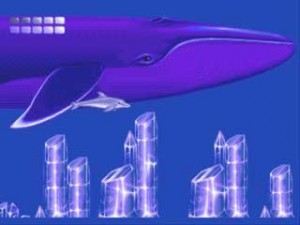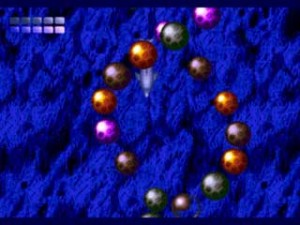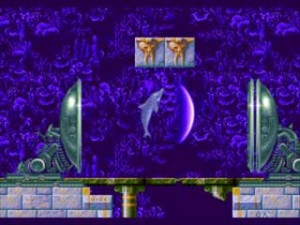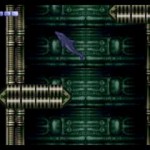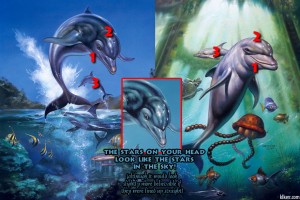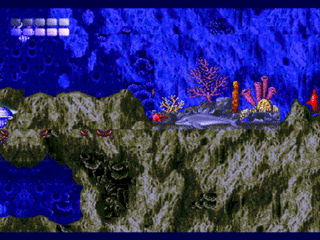When I was a little girl, I – like most girls – had a mild obsession with dolphins, from adopting one (that’s the actual one I adopted: you go adopt him, too!), to cuddly toys, PlayMobil, about a hundred posters and even the Read Your Own Adventure books featuring dolphins and Atlantis (funnily enough, Atlantis seems to be synonymous with dolphins, but I’ll get to that later).
So when I learned there was an entire video game about a dolphin, where you could leap and dance and sing and play and all other such larks, I couldn’t get it quick enough.
Seventeen years on, this game still haunts me. Let me tell you all about it…
Start at the Beginning
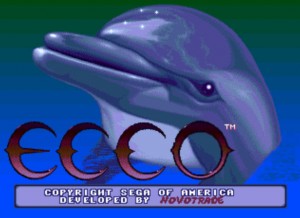 Ecco the Dolphin was released for the Sega Mega Drive (also known as the Sega Genesis, depending on where you come from) in 1992, but I don’t think I got my hands on a Mega Drive until about 1993, so I would have been nine at the time of first getting hold of this game. The age is relevant, considering that both Ecco the Dolphin and its successor, Ecco: the Tides of Time, is notoriously known for its difficulty. And I was nine. I’m not saying that I shouldn’t have been playing this game, or that it was too difficult or any of that. I’m just saying that it was a hard game, and that I appreciate challenging games better because I was introduced to something like this at an early age. Ecco the Dolphin is how I gauge other games’ difficulty. Sad, I know.
Ecco the Dolphin was released for the Sega Mega Drive (also known as the Sega Genesis, depending on where you come from) in 1992, but I don’t think I got my hands on a Mega Drive until about 1993, so I would have been nine at the time of first getting hold of this game. The age is relevant, considering that both Ecco the Dolphin and its successor, Ecco: the Tides of Time, is notoriously known for its difficulty. And I was nine. I’m not saying that I shouldn’t have been playing this game, or that it was too difficult or any of that. I’m just saying that it was a hard game, and that I appreciate challenging games better because I was introduced to something like this at an early age. Ecco the Dolphin is how I gauge other games’ difficulty. Sad, I know.
The Story
The plot starts fairly simple: you are a dolphin, Ecco, and you’re hanging out (do dolphins hang out? Floating about?) with your family (A family of dolphins is known as a pod; see, one sentence in and already you’re learning!) in your little area of the ocean known as Home Bay, when suddenly – oh noes! – a storm sweeps along the ocean floor and sucks up your entire pod as well as the rest of Home Bay’s sea life contents*.

You avoid being taken up by the storm because you’re in the middle of performing some showy and entirely pointless acrobatics out of the water…
The aim of the game is to find out what the storm was, and get your family back.
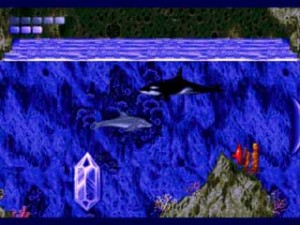 In the first level, you meet a helpful orca, who tells you to seek out a another inhabitant of the ocean called the Big Blue (three guesses for what species the Big Blue is), who lives in the cold waters of the north.
In the first level, you meet a helpful orca, who tells you to seek out a another inhabitant of the ocean called the Big Blue (three guesses for what species the Big Blue is), who lives in the cold waters of the north.
The majority of the early levels are spent travelling to find the Big Blue.
Once you meet him, the Big Blue then directs you to another creature called the Asterite.
So off you toddle to find this other creature who might be able to give you more information about what the storm was that took your pod.
Once you meet with the Asterite, things go…well, they go a bit weird. Everything up to this point has been relatively straight forward. You’re a dolphin; a storm has blown away your family; you want them back; you search the ocean for assistance from the wisest of the ocean’s sea life. And now? Well…
The Asterite tells you that the storm was actually a machine created by an alien race known as the Vortex, who – after losing the ability to create their own food on their planet – visit Earth once every 500 years to feed of Earth’s ocean life. So basically, your pod has been eaten.
But wait! There’s more!
See, the Asterite has super powers that can help you become a Super Dolphin of Awesomeness…but it has been weakened through a missing globe, and before it can give you the powers, you have to go to Atlantis to use a time machine that’s built there to travel back 55 million years to retrieve one of its missing globes from an older/younger version of itself. You might want to read that line a few times. I’ll wait.
So anyway, you do as the Asterite instructs, travel to Atlantis (finding it through that homing beacon all dolphins must have intuitively imprinted into their subconscious), and indeed there is a time machine there, which appears to be built solely for the use of dolphin power, because singing at it is what sets it into motion.
Back in the past, you fight the old (young?) version of the Asterite (it’s understandably pissed at you for trying to steal one of its globes, which begs the question as to whether this was actually how the Asterite lost its globe in the first place, since naturally 55 million years after Ecco comes along and takes it back, the Asterite isn’t exactly going to have re-grown the globe that Ecco steals at this point – quite a mind fuck when you think about it).
In any case, you do get the globe*** and return to the Asterite with it, who then gives you the powers to breathe indefinitely underwater in addition to a super blast charged sonar that can fuck up anyone who even looks at you the wrong way. You use the time machine again to go back to just before the Vortex hit, only this time you stay in the water so that you get taken aboard the mothership with the rest of your pod.
There, you face off with the Vortex queen, kick ten tonnes of shit out of her (or sonar ten tonnes…whatever), free your pod, and go home.
THE END!
The Box Art
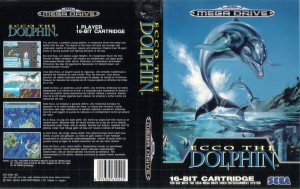 Now that you’re aware of the messed-up storyline, you can see how misleading the game cover actually is. Nothing on this cover suggests time travel, aliens, monstrous but DNA creatures that are as old as the planet itself living in a cave somewhere.
Now that you’re aware of the messed-up storyline, you can see how misleading the game cover actually is. Nothing on this cover suggests time travel, aliens, monstrous but DNA creatures that are as old as the planet itself living in a cave somewhere.
It just looks like a dolphin, having some fun, having to deal with the possibility of being eaten by that shark behind him. No wonder he’s leaping out at you with such vigour. His face may remain innocently expressionless, but his eyes are screaming “Stop taking pictures and HELP ME you sonofabitch!” (Yes, I know it’s a painting – shut up).
…Stop! Gender Bender Time!
I’m just going to veer away from the story a moment and talk about the fact that Ecco the Dolphin is – or, at least was – a genderless dolphin in the first game. Not once did the game refer to Ecco as a ‘he’: not on the box, not in the entire instruction manual, and not in a single in-game text box. Ecco is always, without fail, simply referred to as ‘Ecco’. The more you look into this, the more it becomes apparent that this had to be an intentional decision from the game designers. Dolphins are notoriously androgynous anyway (the funniest explanation for this I found on Yahoo answers:
…The only way to determine a dolphin’s gender in the wild is to see a clear view of their genitals, or to observe an erection, [or an] act of intercourse…
Because, you know, you would watch dolphins ‘at it’ in order to determine which one’s which), so there is no reason why Ecco couldn’t actually be a girl. Of course, if this was the game developers’ attempt to provide deeper player involvement (by only ever referring to Ecco as either ‘Ecco’ or ‘you’, perhaps in the hope that the player would project him/herself into the Ecco sprite), it was a lost cause on me, since I always referred to Ecco as a boy, and I have yet to meet anyone else who thinks otherwise.
It’s also worth mentioning that the ‘genderless’ thing was dropped from the manual in the game’s sequel, Ecco: the Tides of Time, although they did maintain it on the box.
While the box art didn’t differ in purpose in the slightest between the two games (you wouldn’t have any more inkling that the dolphin in the centre of this pictures was either a time-traveller or the salvation for oceans of the world against an alien threat, would you?), there are still some points worth mentioning:
1/ In the first game (supporting this whole genderless theory) Ecco’s appearance is slightly effeminate, even for a dolphin. He is slender, with a delicate pointed nose and an almost waif-like grace. By the second game, he’s beefed up significantly, with less of a “Let’s play!” expression and more of a “Get to da Choppa” look.
2/ Special mention should be made to the stars on Ecco’s head, which to this day I don’t really understand. Whether it’s to pint out that he’s something special (which he isn’t – the only he reason he wasn’t dragged away with the rest of his family was because he was showing off – if he was special, it was something he developed throughout the game), or just random markings, either way you can’t see them in-game, and they only ever come up on the title screen and on the box cover (extra special mention of the fact that the original artwork doesn’t have Ecco’s stars on them, and you can see on the released box art that whoever was told to put them on did a pretty botched job of it, considering they’re not even straight! They improved this by adding them to the original art for Tides of Time, although the artist second time around seemed to forget that dolphins have airholes. Then again, Ecco had already gained his special powers by the beginning of that game, so maybe the artist was being super-clever in pointing out that “Ecco don’t need no airhole, foo’!”. Or maybe I’m thinking too much into it.)
3/ The dolphin “friend” Ecco seems to have stalking him (who doesn’t appear in the game, unless you assume it’s just one of his family). Judging from the cover, you’d be excused into thinking that Ecco was a story about Ecco and his best friend, Pete**.
The Game Itself!
Ignoring the weird story for a minute, the game itself is a simple (and I use the term loosely) 2d sidescroller. You control Ecco through each level, which is mostly a case of find a key glyph and use it to open a locked glyph, which is usually blocking your path, jumping over islands in the water and traversing narrow vents deep underneath.
You have two health bars, one determining how much damage you can take before you die, and the second determining how much air you have. You constantly have to keep Ecco oxygenated, and in the largely underwater-based levels, that can be a real pain in the backside. Most of the times when first playing the game, you will die due to simply running out of air.
You have only one attack, the charge, whereby you can literally head butt the enemy to death. The game fails to mention, however, that at some point the enemies stop dying from just one charge, so you have to turn around and hit them multiple times before they die. Some creatures die in one hit, others don’t, including creatures of the same type. Worse still, especially with the sharks, if you hit them, they will chase you, and generally they move faster than you can, so what happens is you tend to charge, swim past them, then they charge at you while you’re in the middle of trying to turn back around, usually getting you stuck behind them and then dying in the process.
You also have a sonar, which you use to communicate to other friendly creatures, and which you can also use to bring up a sonar image of the nearby area. This is unbelievably handy, since a lot of the time you are in a maze-like environment and it just helps being able to see more than what’s on-screen.
You encounter a myriad of underwater nasties in the game, and it’s true that pretty much everything in Ecco the Dolphin that isn’t another dolphin, an orca, a blue whale or a DNA string, wants you to die. Jellyfish, sharks, spikes, octopuses, blocks of ice, blocks of glass, stone slabs, pufferfish…pretty much everything on the screen, unless you know it’s a key glyph or helpful thing that will get you through the level, you can rest assured, it’s there to hurt you.
In the case of the shellfish, which in level one, one of your oh-so-helpful brothers/sisters tells you that will heal you if you sing to them, occasionally some of those will kill you too.
The game also has little parts that truly make you think the developers were pure evil. Example: in the underwater levels, the air pockets are found at the end of some tunnels, and in early levels, although there is space there, you can only push Ecco’s nose out of the water, rifilling your air guage one by one. In later laters, a lot of these pockets are opened up, allowing you to quickly jump out of the water to refill in one gulp. However, later still, the game adds spikes to the top of these air pockets, so if you – on your last bar and desperately seeking some air – leap out too high, you hit them and take damage. Evil!
Graphics
The graphics were lush for the game’s time; the bright colours of the early levels, the muted and soft colours of the cold north waters, the deep purples and marble whites of Atlantis, contrasted to the more earthy colours of the oceans of the past, and finally the H. R. Giger-esque world of the Vortex, everything was beautifully designed.
The sprites were sharp and detailed, although it would have been nice if Ecco had some kind of distinguishing feature(s) that separated him from every other dolphin in the game, like if the dolphins were grey but he had more of a blueish or purplish hue, à la Abe’s Oddysee. The star marks on his head would have been a nice touch, too, but then again the sprites were kind of small, so it wouldn’t have made much difference even if they had add them.
Music
Much of what can be said about the music has already been mentioned by the graphics, in that the music captured the mood of the level very well. There were two versions of the game soundtrack, one that was created for the 16-bit synthesizer of the Mega Drive, and more orchestral pieces were made for the Sega CD release.
The music in both version were deeply atmospheric, and while people argue that the Sega CD version was a better quality (which – let’s face it – is entirely true), I have to say that a lot of the tracks didn’t feel quite so relevant on the CD version, whereas the music playing in every level of the Mega Drive version fitted its situation perfectly. See the links at the bottom to get a hold of the tracks used in the game.
Game Nuances, Bugs & Room for Improvement
There were only a few niggling things I found wrong with this game (other than the obvious problem of its difficulty when being attempted by a nine-year-old).
The jump mechanics, when it came to getting over large obstructions above the surface, such as islands, bits of broken buildings, and so on. This was most apparent in the City of Forever level, where you had to get Ecco up a series of four floating “rooms”, each one with a higher and wider wall. The problem with the jumps were that if you didn’t get Ecco at least to the half way point on a ledge, he would simply turn around and fall back the way he’d jumped from, and the ability to line Ecco up the right way to ‘prepare’ for a jump were – at times – more frustrating than getting squashed repeatedly by blocks of ice. NOTE: The developers must have realised their faux pas in this instance, since this mechanic was changed in the Tides of Time.
The enemies’ ability to fuse with the environment. Despite the fact that the game was 2D, most of the enemies didn’t care about that little detail, and would tend to swim through the walls and through buildings, meaning that they could still charge at you, but you couldn’t touch them.
And that’s about it, really. Things like the lack of air pockets and the ratio of things that wanted to help you versus things that wanted you dead wasn’t very nice, but indeed it was what made the game such a challenge, even so many years on.
All in All…
Ecco the Dolphin is a slightly surreal but still deeply atmospheric game for the Mega Drive system, deceptively difficult, and a challenge (which – at times – it’s too much of) right through to the end.
______________________________________
* I don’t know about anyone else, but I crapped my pants the first time this happened (since there’s no warning in the story that it’s going to happen), and in the first instance I actually reset my Mega Drive, because I thought I had done something wrong and broken the game.
** The dolphin isn’t really called Pete. Well, I say he isn’t, I don’t actually know that he isn’t, but I think it’s safe to assume Ecco’s pod members are more likely to be named along the lines of Moonbeam or Sunflower.
*** From this point, I’m having to refer to Wikipedia and other resources, as the level where you fight the original Asterite is as far as I got in the game, and I couldn’t complete that level to get any further.
Links of note:
